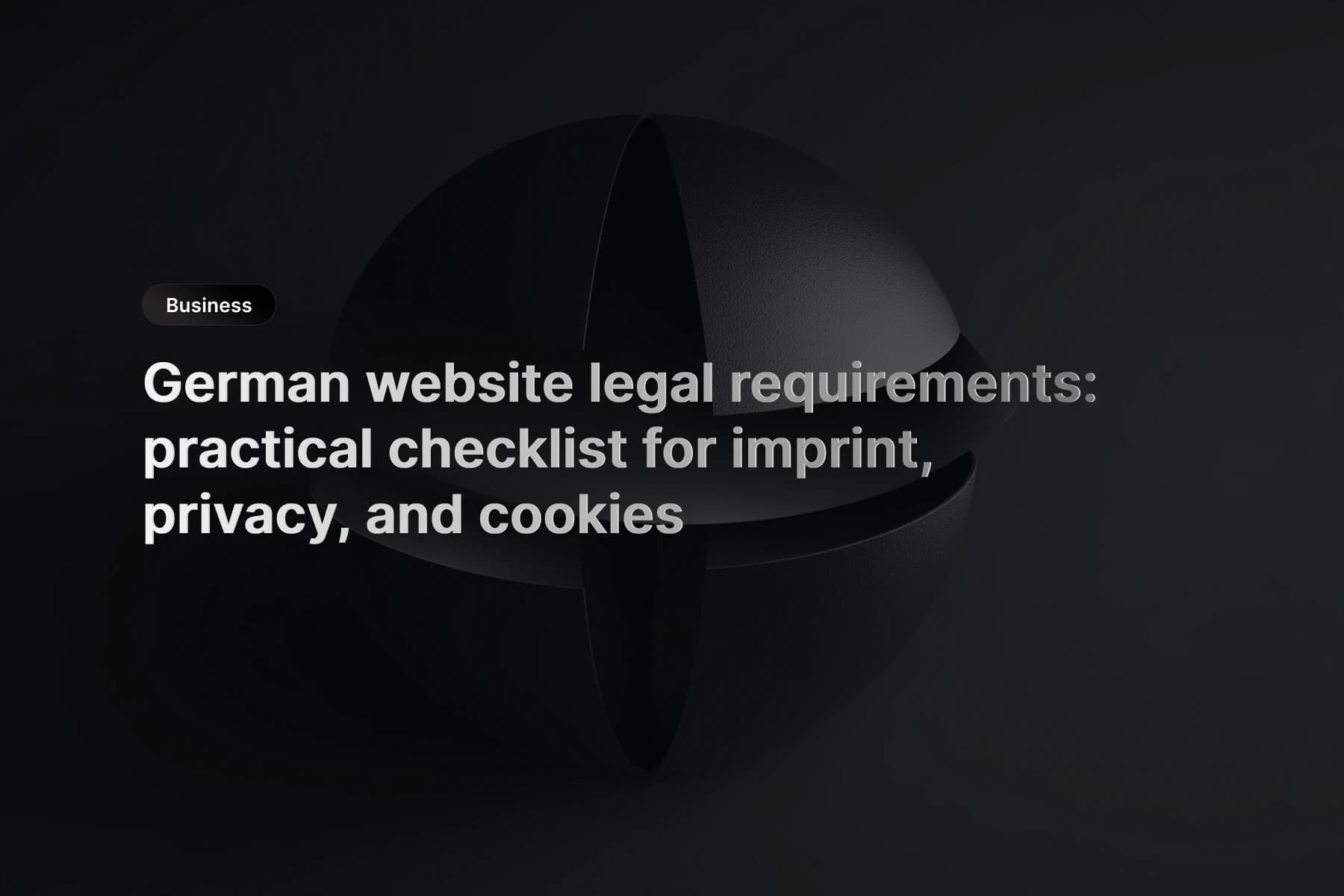This article describes common GDPR concepts around hosting and data residency. It is not legal advice. Laws and regulatory guidance change, and details of your situation matter. For binding guidance, speak with a lawyer or data protection officer who knows your use case.
The data residency myth most German businesses hear
If you run a business website from Germany, you have probably heard at least one of these claims:
“To be GDPR-compliant, your data must stay in Germany.”
“Using any US cloud provider is automatically illegal.”
“EU law requires all data to be stored inside the EU.”
None of these statements is literally what the law says.
The GDPR does not introduce a simple “host only in Germany” rule. Instead, it sets conditions for when personal data can be transferred outside the EU/EEA. Chapter V of the GDPR (Articles 44–49) covers cross-border transfers and offers several tools: adequacy decisions, Standard Contractual Clauses, Binding Corporate Rules, and a handful of specific derogations.
For a German business website, the practical question is not “Where must I host?” but “How do I design hosting and tooling so that our data flows remain manageable and compliant under these rules?”
This article gives a high-level view that is accurate enough to guide technical decisions, while leaving room for your lawyer to refine details for your specific case.
What EU law actually regulates for hosting
From a GDPR perspective, hosting is mostly about two things:
Where personal data is processed and stored.
Whether any of those locations count as “third countries” outside the EU/EEA without an adequacy decision.
Article 44 GDPR makes the principle explicit: any transfer of personal data to a third country or international organisation must comply with the conditions in Chapter V so that EU-level protection is not undermined. Adequacy decisions under Article 45 confirm that a third country provides a comparable level of protection. Standard Contractual Clauses under Article 46 and other safeguards handle transfers where no adequacy decision exists.
Nothing in these articles says that data must always remain in the EU. They do say that, whenever data leaves the EU/EEA, that transfer needs a legal basis and appropriate safeguards under the GDPR.
For a German business website, this means:
- Hosting entirely within the EU/EEA simplifies things because fewer flows count as international transfers.
- Using providers outside the EU/EEA is possible, but you need to use one of the recognised transfer tools and document the reasoning.
Both options can be compliant; they just have different operational trade-offs.
EU hosting: what it simplifies and what it does not
Choosing a hosting provider with data centres in Germany or elsewhere in the EU/EEA can genuinely reduce complexity for many smaller organisations.
When your main infrastructure and backups stay within EU/EEA data centres, most of your processing happens under a single legal regime. You still need proper data processing agreements, security measures, and privacy documentation, but you avoid some of the hardest questions around cross-border transfers and foreign laws.
However, EU hosting is not a magic shield:
If you embed third-party tools that transmit data outside the EU/EEA—analytics scripts, fonts from external CDNs, chat widgets, US-based form tools—you are still making international transfers and must handle them under Chapter V.
If your provider is headquartered outside the EU and uses support teams or logging infrastructure in third countries, parts of the processing may still count as transfers. This depends on the details of the service and configuration.
In other words, “EU data centre” is a strong signal but not the full story. You still need to understand which subprocessors your host uses and where they process data, and you need contracts that reflect these realities.
Using non-EU clouds: how transfers can still be lawful
There are legitimate reasons to use non-EU providers: specific tooling, ecosystem lock-in, or simply team familiarity. EU law does not ban this, but it does require structure.
The main tools for lawful transfers are:
- Adequacy decisions – When the European Commission decides that a third country ensures an adequate level of protection, transfers can happen without additional safeguards. The EU–US Data Privacy Framework, adopted in July 2023, is one such decision for US organisations that are certified under the framework. In September 2025, the EU General Court upheld this adequacy decision in case T-553/23, giving it additional legal stability, although appeals to the CJEU are still possible.
- Standard Contractual Clauses (SCCs) – For countries without an adequacy decision, SCCs are pre-approved contractual clauses that can be used to provide appropriate safeguards for transfers under Article 46 GDPR. The European Commission issued modernised SCCs in June 2021 to replace older sets and published Q&As on how to apply them in practice.
- Other tools – Binding Corporate Rules, approved codes of conduct, or certification mechanisms can also enable transfers, but they are less common for small and mid-size organisations.
In all cases, you are expected to understand the legal environment of the destination country and adopt “appropriate safeguards” so that EU-level protection is not undermined. For most German business websites, this boils down to:
Choosing providers that are either covered by an adequacy decision or offer solid support for SCCs.
Documenting the use of these tools in your data processing agreements and records.
Applying technical measures like encryption, access control, and minimisation to reduce the risk surface.
Hosting choices for a German business website in practice
For many German businesses, a pragmatic approach looks something like this:
Core website hosting, database, and file storage live in an EU/EEA region (for example Frankfurt) with a reputable provider that offers GDPR-ready contracts and clear documentation of subprocessors.
Critical supporting services—monitoring, logging, backup—are chosen with the same approach, favouring EU regions where possible.
Non-EU providers are used selectively where they bring genuine value, and only when they offer recognised transfer mechanisms (such as Data Privacy Framework certification for US services or SCCs for others).
The decision is not binary. You can host the main site and user data in the EU while using a handful of specialist tools from elsewhere under SCCs or the Data Privacy Framework. What matters is that you know where personal data travels and can explain, in plain language, why each transfer is lawful.
When “EU-only” hosting makes sense
There are scenarios where a stricter “EU-only” or even “Germany-only” approach is appropriate:
Your sector has specific regulatory expectations or internal policies that demand EU-only processing.
You handle particularly sensitive categories of data and want to reduce legal and technical complexity as much as possible.
Your customers explicitly demand that their data stay in EU data centres as part of their own compliance strategy.
In these cases, the goal is not only compliance, but also trust. Being able to state clearly that all personal data is processed in EU data centres and never leaves the EU/EEA can be a selling point for privacy-sensitive clients.
Just remember that “EU-only” still requires all the usual GDPR work: clear privacy notices, security measures, and well-structured data processing agreements. It is an architectural decision, not a shortcut.
Using this perspective when you plan your stack
Hosting and data residency decisions are easiest to make early in a project, before you are deep into integrations and long-term contracts.
When you discuss your next website or platform build:
Map out where personal data needs to live and which providers are involved.
Check whether each provider offers EU hosting options and which transfer mechanisms they support for any non-EU processing.
Align the architecture with your risk appetite: EU-first by default, with carefully justified exceptions where non-EU services are essential.
You do not have to solve every edge case on day one. But you should be able to explain why your hosting setup makes sense for a German business operating under the GDPR and how it fits into the larger compliance picture described in the articles on German legal requirements and provider selection.

